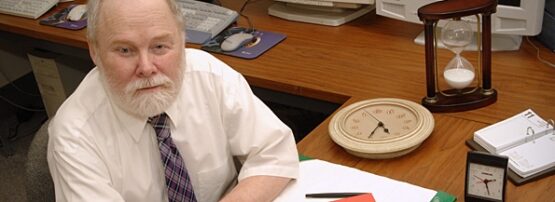
With much sadness, APNIC acknowledges the passing of Emeritus Professor David Mills.
Dave had a huge impact on computer networking and made several significant contributions to the Internet, including one that is still critical to Internet infrastructure operations today.
Dave designed and implemented the ‘Fuzzball’ router, implemented by his code running on an LSI-11 PDP-11 minicomputer. Six of these operated the core of the early Internet running over 56kbps lines. Fuzzballs influenced TCP/IP development and critical features of the IP addressing model, such as variable length subnet masking, were first tested on these systems.
Dave’s most visible work is the Network Time Protocol (NTP), which he invented and codified in RFCs. This protocol is responsible for distributed time synchronization Internet-wide. It’s based on a variety of time sources such as caesium-rubidium clocks (atomic clocks), local clocks on computers, radio-derived clock signals such as DCF77 in the US and JJY in Japan, and ultimately the GPS and other satellite-based time signals. Dave passed authority over the reference implementation of NTP to others in the 2000s but his contribution to this service was immense, lasting for nearly 50 years from 1977 onward.
Born in 1938, David gained a PhD in Computer and Communications from the University of Michigan in 1971. A Professor at the University of Delaware from 1986 to 2008, he was the first chair of the Internet Architecture Task Force (INARC), created under the umbrella of the Internet Architecture Board (IAB) in 1985. This body, along with the IAB, the Internet Engineering Task Force (IETF), and the gateway requirements subcommittee of the US National Science Foundation (NSF), was directly responsible for forming NSFNet, a significant backbone of the Internet until the modern era of commercial providers.
A member of the National Academy of Engineering (NAE), David was also a fellow in the Institute of Electrical and Electronics Engineers (IEEE) and the Association for Computing Machinery (ACM). He received the IEEE 2013 Internet Award.
David was a frequent contributor to online mailing lists and discussions about network protocols and technology, with a witty, distinctive, and pun-filled style of writing. His personal webpage is no exception.
As a keen amateur ham radio licence holder (w3HCF3), Dave had a large antenna at home of which he said: “In emergencies, the rooftop antenna can be converted into helicopter rotor blades and lift the house to safety.” This operating setup included packet radio capabilities, radio time receivers, and reference clock sources.
On behalf of the APNIC community, we pay our respects to David for his massive contribution to education, routing, and network timekeeping.
The views expressed by the authors of this blog are their own and do not necessarily reflect the views of APNIC. Please note a Code of Conduct applies to this blog.
